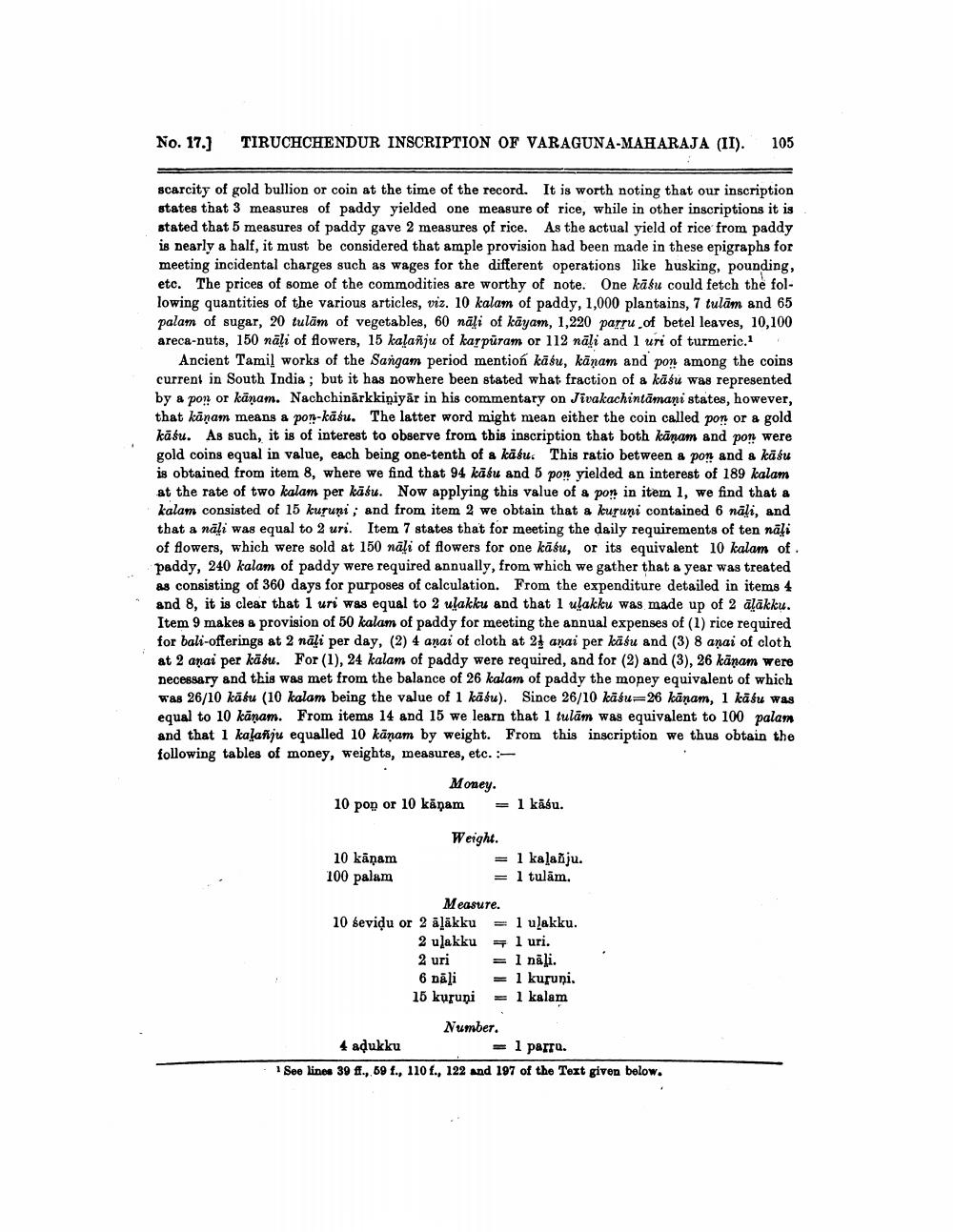________________
No. 17.)
TIRUCHCHENDUR INSCRIPTION OF VARAGUNA-MAHARAJA (II).
105
scarcity of gold bullion or coin at the time of the record. It is worth noting that our inscription states that 3 measures of paddy yielded one measure of rice, while in other inscriptions it is stated that 5 measures of paddy gave 2 measures of rice. As the actual yield of rice from paddy is nearly a half, it must be considered that ample provision had been made in these epigraphs for meeting incidental charges such as wages for the different operations like husking, pounding, etc. The prices of some of the commodities are worthy of note. One kādu could fetch the following quantities of the various articles, viz. 10 kalam of paddy, 1,000 plantains, 7 tulām and 65 palam of sugar, 20 tulām of vegetables, 60 nāli of kāyam, 1,220 parru of betel leaves, 10,100 areca-nuts, 150 näli of flowers, 15 kalanju of karpuram or 112 nāli and 1 uri of turmeric.
Ancient Tamil works of the Sangam period mention kāśu, kāņam and pon among the coins current in South India ; but it has nowhere been stated what fraction of a kāśu was represented by a pon or kānam. Nachchinārkkiniyār in his commentary on Jivakachintāmaņi states, however, that kāņam means a pon-kāšu. The latter word might mean either the coin called pon or a gold kāśu. As such, it is of interest to observe from this inscription that both kāņam and pon were gold coins equal in value, each being one-tenth of a kašu. This ratio between a pon and & kāśu is obtained from item 8, where we find that 94 kāśu and 5 pon yielded an interest of 189 kalam at the rate of two kalam per kāśu. Now applying this value of a pon in item 1, we find that a kalam consisted of 15 kuruni ; and from item 2 we obtain that a kuruni contained 6 näli, and that a nāli was equal to 2 uri. Item 7 states that for meeting the daily requirements of ten nāļi of flowers, which were sold at 150 nāļi of flowers for one kāśu, or its equivalent 10 kalam of paddy, 240 kalam of paddy were required annually, from which we gather that a year was treated as consisting of 360 days for purposes of calculation. From the expenditure detailed in items 4 and 8, it is clear that 1 uri was equal to 2 ulakku and that 1 ulakku was made up of 2 āļākku. Item 9 makes a provision of 50 kalam of paddy for meeting the annual expenses of (1) rice required for bali-offerings at 2 nāli per day, (2) 4 anai of cloth at 21 anai per käsu and (3) 8 anai of cloth at 2 anai per kātu. For (1), 24 kalam of paddy were required, and for (2) and (3), 26 känam were necessary and this was met from the balance of 26 kalam of paddy the money equivalent of which was 26/10 kātu (10 kalam being the value of 1 kasu). Since 26/10 käsu=26 kānam, 1 kāśu was equal to 10 kanam. From items 14 and 15 we learn that 1 tulam was equivalent to 100 palam and that 1 kalafiju equalled 10 kānam by weight. From this inscription we thus obtain the following tables of money, weights, measures, etc. :
Money. 10 pop or 10 kāņam = 1 kāśu.
Weight 10 kāņam
= 1 kalaõju. 100 palam
= 1 tulām.
Measure. 10 seviļu or 2 ālākku = 1 ulakku.
2 ulakku = 1 uri. 2 uri = 1 nāli. 6 nāli = 1 kuruņi. 15 kuruņi = 1 kalam
Number. 4 adukku
= 1 partu. See lines 39 ff., 69 1., 110 f., 122 and 197 of the Text given below.
.




